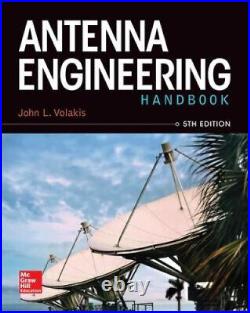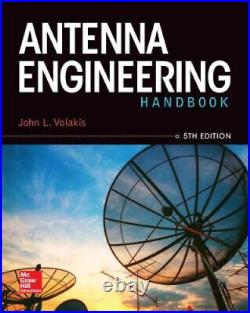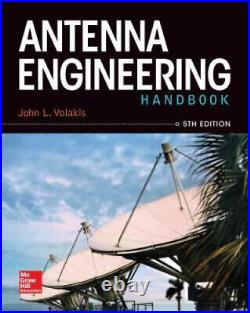Antenna Engineering Handbook by John Leonidas Volakis





Part 1 Introduction and Fundamentals. Fundamentals of Antennas, Arrays, and Mobile Communications. 1.2 Huygens’ and Equivalence Principles. 1.3 Hertzian and Fitzgerald Radiators. 1.4 Far-Field Antenna Properties, Power Transfer, and Reciprocity. 1.5 Antennas as Electromagnetic Circuits. 1.7 Directivity Patterns from Continuous Line Sources. 1.8 Directivity Patterns from Area Source Distributions. 1.9 Fundamentals of Antenna Arrays. 1.10 Basic Concepts in Mobile Communications. Frequency Bands for Military and Commercial Applications. 2.1 Introduction to Frequency Bands. 2.2 Commercial Frequency Bands. 2.3 Military and Satellite Frequency Bands. 2.4 Trends and Expected Future Paths. Arrays of Discrete Elements. 3.2 Antenna Array Factor and Antenna Indices. 3.3 Linear Arrays. 3.4 Planar Arrays. 3.5 3D and Conformal Arrays. 3.6 Array Synthesis Techniques. 3.7 Smart Antennas. 3.8 Element Pattern and Mutual Coupling. Part 2 Types and Design Methods. Classic Antennas: Dipole, Monopole, Loop, and Slot Antennas. 4.2 Dipole Antennas. 4.3 Loop Antennas. 4.4 Slot Antennas. 5.2 Axial-Mode Helical Antennas. 5.3 Normal-Mode Helical Antennas. 5.4 Array of Helical Antennas. 5.5 Fractional-Turn Resonant Quadrifilar. 5.6 Short Axial-Mode Helical Antennas. 5.7 Backfire Axial-Mode Helical Antennas. 5.8 Recent Trends Employing Helical Antennas. 6.1 The Definition of Electrically Small. 6.2 The General Electrically Small Antenna. 6.3 Electrically Small Dipole and Loop Antennas. 6.4 Power Factor, Quality Factor, and Bandwidth. 6.5 The Effective Volume. 6.6 Fundamental Limits on Small Antenna Q. 7.2 Basic Principles of Operation. 7.3 CAD Model for the Input Impedance. 7.4 Radiation Patterns. 7.5 CAD Formulas for Rectangular Patch. 7.6 Results for Rectangular Patch. 7.7 CAD Formulas for Circular Patch. 7.8 Circular Polarization. 7.9 Microstrip Antennas with Improved Performance. Multiband Planar Antennas for Wireless Communications. 8.1 Multiband Planar Antenna Arrays. 8.2 Multiband Antennas in the Smartphone. 9.2 Substrate Effect on Bandwidth. 9.3 Effect of Patch Shape on Bandwidth. 9.4 Proximity Coupled Microstrip Antennas. 9.5 Aperture Coupled Microstrip Antennas. 9.6 Stacked Microstrip Patch Antennas. 9.7 High-Gain Stacked Patch Antennas. 9.8 Slotted Wideband Patch Antennas. 9.9 Microstrip Patch Antennas with EBG. 9.10 Effects of Size Reduction on Wideband Antennas. Small Antennas and Miniaturization Techniques. 10.2 Antenna Miniaturization with Metamaterial Loadings. 10.3 Low-Profile Antennas Using EBG Structures. 10.4 Antenna Miniaturization Using Magnetodielectric Materials. 10.5 Volumetric Antennas. 10.6 Additive Manufacturing of Antennas. 10.7 Concluding Remarks. Flexible, Thin Film, and Wearable Antennas. 11.2 Flexible Antenna Designs and Operation Frequencies. 11.3 Thin Film (Non-Fabric) Antennas. 11.4 Fabric-Based Antennas. 11.5 Flexible Antenna Applications. 11.6 Future Directions. 12.1 Origami Monofilar Helical Antenna. 12.2 Morphing Origami Conical Spiral Antenna. 13.2 Radiation-Efficiency-Improved Millimeter-Wave On-Chip Antennas. 13.3 Miniaturized On-Chip Antenna for Biomedical Applications. 14.1 Introduction and Basic Terms. 14.2 Frequency-Agile Active Antennas. 14.3 Oscillator Antennas and Arrays. 14.4 Amplifier Antennas and Arrays. 14.5 Frequency-Conversion Antennas. 14.7 Other Active Antennas. Surface-Wave and Leaky-Wave Antennas. 15.2 Surface-Wave Antennas. 15.3 Leaky-Wave Antennas. Waveguide Slot Antenna Arrays. 16.2 Waveguide Slot Radiators. 16.3 Slotted Waveguide Array Designs. 16.4 Slot Admittance or Impedance. 16.5 Design Parameters. 16.7 Tolerance and Fabrication Techniques. 17.2 Performance Metrics of MIMO Antenna Systems. 17.3 MIMO Antennas for USB Dongles. 17.4 MIMO Antennas for Mobile Phones. 17.5 MIMO Antennas for Wireless Access Points. 17.6 Reconfigurable MIMO Antennas for Cognitive Radios. 17.7 MIMO Antennas for 5G Systems. 18.1 Spiral Antennas. 18.2 Log-Periodic Antennas. 18.3 Dual-Polarized Frequency-Independent Antennas. 19.2 Basic Horn Types. 19.3 Other Classes of Horns. 19.4 Recent Developments in Horn Design and Technology. 20.2 Diffraction Analysis Techniques for Reflector Antennas. 20.3 Conventional Reflector Antennas. 20.4 Reflectors Other Than Parabolic. 20.5 Large-Aperture Reflector Antennas. 20.6 Diffraction Shaping. 20.7 Emerging Applications of Mesh Reflector Antennas. 21.2 Possible Methods of Analysis. 21.3 Progress in DRA Research. 21.4 DRA Arrays. Ultra-Wide Bandwidth Antenna Design. 22.2 Fundamentals of UWB Antenna Design. 22.3 Type-I UWB Antenna Design. 22.4 Type-II UWB Antenna Design. 22.5 Type-III UWB Antenna Design. 22.6 The Dual-Polarization UWB Dielectric Rod Probe Antenna. 22.7 The Dual-Polarization UWB Dielectric Horn Antenna Design. 23.2 Theory of Phased Arrays. 23.3 Pattern Control. 23.4 Radiating Element Design. 23.5 Phased Array Antenna Architectures. Array Phase Shifters: Theory and Technology. 24.3 Thin Film Ferroelectric. 24.4 Micro-Electromechanical Systems. 24.7 Effect of Phase Shifter Behavior on Phased Array Bit Error Rate. Conformal and Low-Profile Arrays. 25.2 Fundamental Principles. 25.3 Antennas and Arrays on Cylinders. 25.4 Pattern Synthesis for Conformal Arrays. 26.1 Millimeter-Wave Applications. 26.2 Types of Millimeter-Wave Antennas. Terahertz Antennas and Arrays. 27.1 Terahertz Applications. 27.2 Quasi-Optical Coupling of Terahertz Radiation. 27.3 Terahertz Antennas. 27.4 THz Antenna Arrays. 28.1 Nanocircuits and Nanoantennas. 28.2 Metamaterial-Inspired Nanoantennas. 28.3 Optical Magnetism in Nanoantennas. 28.4 Nanoantenna Directivity. 28.5 Active Nanoantennas. 28.6 Nonlinear Nanoantennas. 28.7 Enhanced Emission and Quantum Responses with Nanoantennas. Ultra-Wideband Dipole, Monopole, and Loop Arrays. 29.1 Resistively Loaded Dipole and Monopole Arrays for Ground Penetrating Radar. 29.2 Cylindrical Dipole Arrays for Airborne Systems. 29.3 Vector Sensor Array Antennas. 30.1 Applications of Ultra-Wideband Phased Arrays. 30.2 Tapered Slot Antenna. 30.3 Connected and Tightly Coupled Arrays. 31.2 Adaptive Beamforming. Metamaterial Electronically Scanning Array. 32.2 Theory of MESA Antennas. 32.3 Realized K-Band MESA: Modeling and Measurements. Low- and Medium-Frequency Antennas. 33.2 Fundamentals of Vertical Monopole Antenna Radiation Properties. 33.3 Practical Low and Medium Antenna Structures: Design and Construction Basics. 33.4 Environmental Considerations. 34.2 Specifying the Right Antenna for the Job. 34.3 Antennas Mounted Above Ground. 34.4 Major Forms of HF Communications Antennas. 34.5 Other Types of HF Communications Antennas. 34.6 Broadband Dipole Curtain Arrays. 35.2 Antennas for the ISM Bands (Typically 433 MHz, 868/915 MHz, and 2.4/5 GHz). 35.3 Antennas for Global Navigation Satellite Systems. 35.4 Antennas on Printed Circuit Laminates. 35.5 Antennas for Point-to-Point and Point-to-Multipoint Services. 35.7 Exposure to Electromagnetic Fields. 36.2 R econfigurable Apertures. 36.3 Reconfigurable Traveling Wave Antennas. 36.4 Reconfigurable Arrays. 36.5 Reconfigurable Microstrip Antennas. 36.6 Reconfigurable Slot Antennas. 36.7 Reconfigurable Monopole/Dipole Antennas. 36.8 Concluding Remarks. Low-Profile Antennas on Engineered Electromagnetic Surfaces. 37.2 Characterizations and Designs of Electromagnetic Band-Gap Structures. 37.3 Low-Profile Wire Antennas on EBG Ground Plane. 37.4 Patch Antennas with Enhanced Performance Using EBG Structures. 37.5 Impedance and Magneto-Dielectric Substrates for Small Antenna Designs. 38.2 Analysis and Design Techniques. 38.3 Techniques for Bandwidth Improvement. 38.4 Multifrequency Reflectarrays. 38.5 Contoured Beam Reflectarrays. 38.6 Beam Scanning Reflectarrays. 38.7 Recent Developments and Technological Challenges. 39.2 Handset Antenna Types. 39.3 Design Aspects of Handset Antennas. 39.4 Fabrication Technologies for Handset Antennas. 39.5 Active Handset Antennas. 39.7 Conclusion and Remarks. 40.2 Base Station Antenna Requirements. 40.3 Base Station Antenna Radiating Elements. 40.4 Multibeam Antennas. 41.1 Traditional CubeSat Antennas. 41.2 Conformal Integrated Solar Panel Antennas. 41.3 High-Gain Antennas. 3D Additive Manufacturing of Antennas. 42.2 Additive Manufacturing Techniques for Antenna Applications. 42.3 Additive Manufacturing-Enabled Antennas. 42.4 Additive Manufacturing of Antenna Arrays and Systems. Antennas for Medical Applications. 43.2 The Environment. 43.3 Antennas for Medical Imaging. 43.6 Pulsed Electromagnetic Fields. 43.8 Future Directions. 44.3 FM Diversity Antennas. 44.4 RKE and TPMS Antennas. 44.5 Mobile Telephone Antennas. 44.6 GNSS Antennas. 44.7 SDARS Antennas. 44.8 DSRC Antennas. 44.9 Emerging Technologies (Observed). 44.10 Emerging Technologies (Predicted). 44.11 Antenna Measurements. 45.2 Low-Frequency and High-Frequency Antennas. 45.3 Unidirectional Very-High-Frequency Antennas. 45.4 Omnidirectional VHF and UHF Antennas. 45.5 Omnidirectional L-Band Antennas. 45.6 GPS Antennas. 45.7 Traffic Collision Avoidance System Antennas. 45.8 Satellite Communication (SATCOM) Antennas. 45.9 Low Observable Antennas. 45.10 Nonmetallic Aircraft Antennas. 45.11 Small Aircraft Antennas. 45.12 Radar Antennas. 45.13 Electronic Warfare. 45.14 Antenna Performance and Aircraft Interaction. 46.2 Basic Principles. 46.3 System Principles. 46.4 Radiometer Antenna Types. 46.5 Recent Developments and Trends in Radiometry. 47.2 Tracking Requirements. 47.3 Open Loop Antenna Tracking. 47.4 Closed Loop Antenna Tracking. 47.5 Acquisition Issues. 47.6 Interferometric Systems. 47.7 Antenna Tracking Evaluation. 48.2 Space Segment Antennas. 48.3 Ground Segment Antennas. 48.4 Interference Protection. 48.5 Satellite Antenna Testing. 49.2 Single-Beam Earth Station Antennas. 49.3 Multiple-Beam Earth Station Antennas. 49.4 Measurement Techniques. Direction Finding Antennas and Systems. 50.2 Direction Finding Systems. 50.3 Direction Finding Algorithms. 50.4 DF Algorithm Performance. 50.5 Geolocation Algorithms. ESM and ECM Antennas. 51.2 Communication ESM and ECM System Antennas. 51.3 Radar ESM and ECM System Antennas. 52.2 Single-Aperture Radio Telescopes. 52.3 The Two-Element Interferometer. 52.4 Aperture Synthesis. 52.5 Major Radio Telescopes. 53.2 Test Setup and Calibration. 53.3 Typical Antenna Measurement Properties. 53.4 Data Analysis Tools. Part 4 Topics Associated with Antennas. 54.2 Printed Transmission Lines. 54.3 List of Symbols. Impedance Matching, Broadbanding, and Baluns. 55.1 General Matching Techniques. 55.2 Impedance Matching with Lumped Elements. 55.3 Impedance Matching with Distributed Elements. 55.4 Combinations of Transformers and Stubs. 55.5 Tapered Lines. 56.1 Introduction and Overview of Propagation Effects. 56.2 Free-Space Propagation. 56.3 Atmospheric Refraction. 56.4 Atmospheric Gas and Rain Attenuation. 56.5 Empirical Path Loss Models for Line-of-Sight Links. 56.6 Fading and Multipath. 56.7 Ionospheric Effects at Microwave Frequencies. 56.8 Ionosphere and Ground Wave Effects at Frequencies Less Than 50 MHz. Materials and Design Data. 57.1 Properties of Materials. 57.2 Absorbing Materials. 57.3 Nonsolid Surfaces. 57.4 Radio-Frequency Band Designations. 57.5 Antenna-Pattern Characteristics. 57.6 Electrically Small Horns. 58.2 Single-Layer Surfaces. 58.3 Multilayer Surfaces. 58.4 Three-Dimensional Structures. 58.5 Active FSSs. Advanced Huygens’ Metasurfaces for Beam Manipulation and Antenna Applications. 59.2 Scalar Huygens’ Metasurfaces. 59.3 Scalar (Omega) Bianisotropic Huygens’ Metasurfaces. 59.4 Concluding Remarks. Computational Electromagnetics for Antennas. 60.2 Electromagnetics for Antenna Engineering. 60.3 Integral Equation Formulations for Antenna Analysis. 60.4 MoM and FEM Procedure for Solving Linear Operator Equations. 60.5 Examples of MoM Discretizations of Integral Equations for Antennas. 60.6 Finite Element Method in Antenna Analysis and Design. 60.7 Finite-Difference Time-Domain Method for Antennas. 60.8 Postprocessing: Evaluation of Antenna Parameters. 60.9 Parallelization and High-Performance Computing for Antenna Modeling. 60.10 Commercial Codes for Antenna Analysis and Design.

« Clearstream 4Max TV Antenna, 70+ Mile Range, UHF/Vhf, Multi 70 Mile (Previous News)
Related News

RV TV Antenna Amplified Digital HD TV Antenna with Long Range Reception, White
RV TV Antenna Amplified Digital HD TV Antenna with Long Range Reception, Easy Installation –Read More

Antenna and Array Technologies for Future Wireless Ecosystems by Yingjie Jay Guo
Antenna and Array Technologies for Future Wireless Ecosystems. By Yingjie Jay Guo, Richard W. ANTENNARead More


Comments are Closed